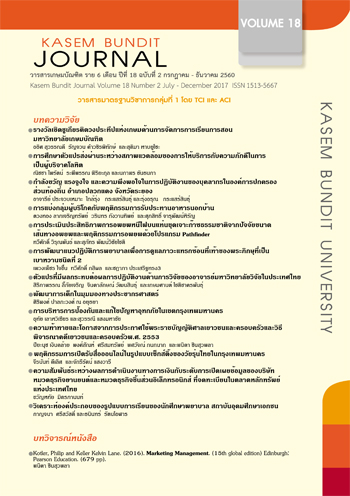การศึกษาตัวแปรส่งผ่านระหว่างสภาพแวดล้อมของการให้บริการกับความภักดีในการเป็นผู้บริจาคโลหิต
Keywords:
การบริจาคโลหิต, ปัจจัยส่งผ่าน, ความภักดีในการเป็นผู้บริจาคโลหิตAbstract
การวิจัยนี้ศึกษาสภาวะแวดล้อมทางสังคม และทางกายภาพในด้านการบริการรับบริจาคโลหิต และการรับรู้คุณค่า ความพึงพอใจ และความเชื่อมั่นในศูนย์บริจาคโลหิต ต่อความภักดีในการเป็นผู้บริจาคโลหิต เก็บข้อมูลเชิงประจักษ์จากกลุ่มตัวอย่างที่เป็นผู้บริจาคโลหิต จำนวนทั้งสิ้น 500 ราย นำผลที่ได้มาวิเคราะห์สมการโครงสร้าง (SEM) ด้วยโปรแกรมสำเร็จรูป Smart PLS Graph และ AMOS ผลการศึกษาแสดงให้เห็นว่า สภาวะแวดล้อมทางสังคม ในด้านบรรยากาศสภาพแวดล้อมของผู้บริจาคโลหิตกลุ่มเครือข่ายสังคมค่านิยมและมีความคิดด้านจิตสาธารณะ ช่วยเหลือสังคม มีผลโดยตรงต่อการรับรู้ถึงคุณค่าของการบริจาคโลหิต การแสดงอารมณ์ของเจ้าหน้าที่ผู้ให้บริการส่งผลต่อความพึงพอใจในการบริจาคโลหิต สำหรับสภาวะแวดล้อมทางกายภาพนั้น คุณภาพการบริการที่ดีของศูนย์บริการโลหิตที่ได้มาตรฐาน โดยเฉพาะอย่างยิ่งความชำนาญของบุคลากรวิชาชีพ มีผลต่อความพึงใจในการบริจาคโลหิตและความเชื่อมั่นในศูนย์บริจาคโลหิตอย่างมีนัยสำคัญ และนำไปสู่ความภักดีในการเป็นผู้บริจาคโลหิต
This research looked into of the effects of the service delivery environments (social and physical) on blood donation loyalty through mediating variables i.e., the perceived value of donation, donation satisfaction and trust in blood donation centre respectively. Structural equation modeling was applied by means of smart PLG graph and AMOS. Empirical data was collected by questionnaires that were distributed after blood donation to 500 donors. The results showed that social environment, particularly social network, value and public mind to help society directly influenced the perceived value of donation while the positive staff emotion resulted in positive donation satisfaction. For physical environment, the service delivery quality e.g., the blood donation tools and equipment, especially, the staff expertise, significantly and directly affected the donors’ satisfaction, and led to blood donor loyalty.
References
Bitner, M.J. (1992). “Servicescapes: the impact of physical surroundings on customers and employees”, Journal of Marketing, Vol. 56 (2), pp. 57-71.
Brocato, E.D. and Kleiser, S.B. (2005). “Influence of other customers: a scale development”, American Marketing Association, Conference Proceedings, Vol. 16, p. 128.
Burns, D.J. and Neisner, L. (2006). “Customer satisfaction in a retail setting – the Contribu-tion of emotion”, International Journal of Retail & Distribution Management, Vol. 34, 1, pp. 49-66.
Cronin, J.J. Jr, Brady, M.K. and Hult, G.T.M. (2000). “Assessing the effects of quality, value, and customer satisfaction on consumer behavioral intentions in service environments”, Journal of Retailing, Vol. 76(2), pp. 193-217.
Donovan, R. and Rossiter, J. (1982). “Store atmosphere: an environmental psychology approach”, Journal of Retailing, Vol. 58 (1), pp. 34-57.
Glynn SA, Williams AE, Nass CC, Bethel J, et al. (2003) .Attitudes towards blood donation incentives in the United States: Implications for donor recruitment. Transfusion, Vol. 43(1): 7–16.
Han, H. and Ryu, K. (2009). “The roles of the physical environment, price perception, and customer satisfaction in determining customer loyalty in the restaurant industry”, Journal of Hospitality and Tourism Research, Vol. 33 (4), pp. 487-510.
Harsandaldeep K.(2013). Mediating role of Commitment and Corporate Image in The Formation of Customer Loyalty, Journal of India Business Research, Vol. 5 (1) pp. 34-57.
Hennig-Thurau, T., Groth, M., Paul, M. and Gremler, D.D. (2006). “Are all smiles created equal? How emotional contagion and emotional labor affect service relationships”, Journal of Marketing, Vol. 70 (3), pp. 58-73.
Jang, S. and Namkung, Y. (2009). “Perceived quality, emotions, and behavioral intentions: application of an extended Mehrabian-Russell model to restaurants”, Journal of Business Research, Vol. 62 (4), pp. 451-60.
Kuruppa KK.(2010). “Management of Blood system in disaster” January 2010,Vol.38(1):87-90:Journal Advance in Transfusion Safety pp.1-104
Marsh, H. W., & Hocevar, D. (1985). Application of confirmatory factor analysis to the study of self-concept: First- and higher order factor models and their invariance across groups. Psychological Bulletin, 97, 362-582.
McCarthy,L.T.(2007).“How do I manage a blood shortage in transfusion service? ”Transfusion, Vol.47,760-762.
Moore, R., Moore, M.L. and Capella, M. (2005). “The impact of customer-to-customer interactions in a high personal contact service setting”, Journal of Services Marketing, Vol. 19 (7), pp. 482-91.
Nguyen D, DeVita D, Hirschler N, Murphy E. (2008). “Blood donor satisfaction and intention on future donation” Transfusion, Vol. 48(4): 742–748.
Nyer, P.U. (1997). “A study of the relationships between cognitive appraisals and consumption emotions”, Academy of Marketing Science Journal, Vol. 25 (4), pp. 296-301.
Pugh, S.D. (2001). “Service with a smile: emotional contagion in the service encounter”, Academy of Management Journal, Vol. 44 (5), pp. 1018-27.
SNBTS,(2006). The Scottish National Blood Transfusion Service Transfus Med Hemother. 2006 Vol. 38(6): 373–378
WHO., (2013).World health Report 2013: Research For universal Health Coverage
Zou S, Musavi F, Notari EP, Fang CT. (2008). “Changing age distribution of the blood donor population in the United States”. Transfusion, Vol. 48(2): 251–257.
Downloads
Published
How to Cite
Issue
Section
License
ทัศนคติ ความคิดเห็นใด ๆ ที่ปรากฏในวารสารเกษมบัณฑิตฉบับนี้เป็นของผู้เขียน โดยเฉพาะ มหาวิทยาลัยเกษมบัณฑิตและบรรณาธิการ ไม่จำเป็นต้องมีความเห็นพ้องด้วย







